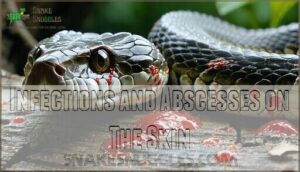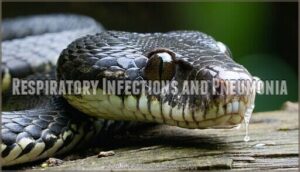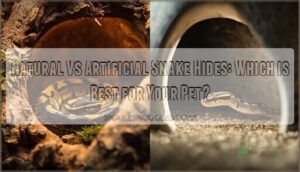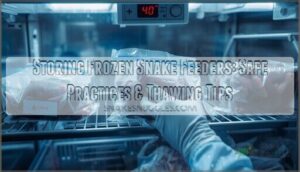This site is supported by our readers. We may earn a commission, at no cost to you, if you purchase through links.
 You’ll face several common snake care problems that can turn dangerous fast.
You’ll face several common snake care problems that can turn dangerous fast.
Temperature swings stress your snake and weaken its immune system, while poor humidity leads to shedding disasters.
Respiratory infections show up as mouth breathing and wheezing – they’re serious business.
Mites spread like wildfire between snakes, causing endless scratching and irritation, while overfeeding creates obesity and regurgitation issues.
Your snake’s specific species needs matter too – what works for a ball python won’t work for a corn snake, and dirty enclosures breed bacteria and parasites.
These problems often snowball together, creating a perfect storm of health issues that experienced keepers know how to spot early, which can be critical to preventing further complications.
Table Of Contents
- Key Takeaways
- Snake Health Issues
- Common Snake Care Mistakes
- Snake Shedding and Skin Problems
- Snake Respiratory and Digestive Issues
- Preventing Snake Health Problems
- Frequently Asked Questions (FAQs)
- What are the most common health problems seen in pet snakes?
- What are the signs of illness in snakes?
- What health problems do snakes have in captivity?
- Do snakes have respiratory problems?
- Are snakes prone to health problems?
- How to prevent spiraling snake health problems?
- How can I tell if my snake is sick?
- What are some specific symptoms of common illnesses in snakes?
- Why is shedding a concern for snake health?
- What are some signs of respiratory problems in snakes?
- Conclusion
Key Takeaways
- You can prevent most health problems by maintaining proper temperature gradients (70-90°F), humidity levels (50-70%), and cleaning enclosures weekly – these basics stop respiratory infections, shedding issues, and bacterial growth before they start
- Watch for early warning signs like appetite changes, breathing problems, or stuck shed skin – catching issues early prevents minor problems from becoming life-threatening emergencies that require expensive vet visits
- Research your specific snake species thoroughly before buying – ball pythons need different care than corn snakes, and assuming general reptile advice works for all species leads to serious health problems
- Don’t panic when problems arise, but act quickly – most snake health issues are treatable if you address them promptly with proper veterinary care and fix underlying husbandry problems
Snake Health Issues
Your snake’s health depends on recognizing early warning signs that many owners miss.
These four major health categories can quickly turn from minor concerns into life-threatening emergencies if you don’t catch them in time.
Anorexia and Poor Hydration
Appetite loss and dehydration form a deadly duo in snake care.
Without proper hydration, your snake’s appetite won’t return—fix water first, food second.
Poor husbandry, stress, or underlying conditions cause anorexia, while dehydration worsens everything.
You’ll spot snake dehydration symptoms like wrinkled skin and sunken eyes.
One key indicator is loss of skin elasticity.
Snake anorexia treatment requires fixing husbandry first, then addressing medical issues.
Hydration methods include warm electrolyte baths and proper humidity, which can help with appetite stimulation and successful rehydration.
Appetite stimulation follows successful rehydration and environmental corrections, making it crucial to address husbandry and medical issues promptly.
Respiratory Infections and Diseases
When your snake starts wheezing or shows labored breathing, you’re likely dealing with respiratory infections.
These bacterial infections cause mucus buildup that blocks airways, making breathing tough.
Watch for mouth breathing or unusual sounds.
Pneumonia treatment requires immediate vet care – they’ll prescribe antibiotics and may recommend oxygen therapy for severe cases.
Don’t wait on respiratory problems.
Skin Abnormalities and Shedding Problems
Watch for Scale Rot and Mite Infestations that signal serious snake skin problems.
Dysecdysis causes stuck shed, creating perfect conditions for snake skin infection and Scar Tissue formation.
You’ll notice Color Changes and blister-like bumps requiring immediate Blister Treatment.
Snake shedding problems worsen without proper humidity, turning minor issues into major headaches that’ll cost you dearly.
Nutritional Deficiencies and Parasites
Poor nutrition creates a domino effect in your snake’s health.
Vitamin D3 deficiency causes bone deformities, while fish-heavy diets trigger thiamine shortages.
Parasites like nematodes and Cryptosporidium compound these issues, causing weight loss and regurgitation.
Freeze prey items before feeding, maintain proper supplementation, and establish consistent feeding schedules for parasite prevention.
Mites are common ectoparasites, so make certain proper quarantine procedures to prevent reptile mite infestations.
Common Snake Care Mistakes
Even experienced snake owners make critical mistakes that can kill their pets. These common errors often stem from inadequate preparation and poor understanding of basic snake care requirements.
Improper Enclosure Setup and Maintenance
Creating the perfect snake home isn’t just about buying a tank and tossing in some substrate.
Your enclosure size must match your snake’s adult length, while substrate choice affects humidity and cleanliness.
Strategic hiding spots reduce stress, and clean water quality prevents bacterial growth.
Don’t forget enrichment items like branches for climbing species—proper snake care means designing a complete snake environment, not just basic snake enclosure essentials.
A vital aspect is maintaining the correct temperature gradient for ideal health, which is a key part of complete snake environment and proper snake care, ensuring clean water quality and the right enclosure size.
Inadequate Temperature and Humidity Control
Temperature gradients aren’t optional—they’re lifelines. Your snake needs a warm basking spot and cooler retreat area to regulate body temperature properly.
Without proper thermostat calibration and monitoring equipment, you’re gambling with your pet’s health. Species requirements vary dramatically, so research your specific snake’s needs.
Proper setup requires reliable temperature control. Humidity sources must match environmental factors too, or shedding problems will follow, which can be a significant threat to your pet’s health and well-being, emphasizing the need for precise temperature control.
Poor Hygiene and Handling Practices
Dirty enclosures create infection risk and stress induced health problems for your snake.
You’re basically rolling out the red carpet for bacteria and parasites when you skip regular cleaning.
Improper handling during routine maintenance adds unnecessary stress, while neglecting quarantine protocols can spread diseases between animals.
Clean substrate, disinfected water bowls, and gentle handling techniques prevent most common health issues, reducing the risk of infection.
Inadequate Research on Species-Specific Needs
Most snake owners make assumptions about care based on general reptile advice.
Over 90% of non-venomous snake species lack detailed husbandry protocols, leaving you guessing about Species-Specific Diets and Habitat Replication.
Your ball python’s Enrichment Needs differ vastly from your corn snake’s Temperament Considerations.
Without proper research on snake species requirements, you’re setting up your pet for common health problems and shortened Lifespan Expectations.
Snake Shedding and Skin Problems
Your snake’s skin health directly impacts its overall well-being, and shedding problems can quickly escalate into serious medical issues.
Understanding these common skin conditions helps you catch problems early and keep your pet healthy.
Dysecdysis and Retained Spectacles
Poor enclosure maintenance creates perfect conditions for shedding problems.
When humidity drops below 50%, your snake’s skin becomes less elastic, making normal shedding nearly impossible.
Dysecdysis – incomplete shedding – affects vision and circulation, while retained eye caps can cause blindness.
Here’s how to prevent snake stuck shed:
- Maintain 50-70% humidity during shedding cycles using water bowls or misting
- Provide rough surfaces like bark or rocks for natural eye cap removal assistance
- Monitor shedding frequency – healthy snakes shed every 4-8 weeks depending on age
Watch for cloudy eyes signaling upcoming sheds.
Preventative care beats emergency vet visits every time.
Infections and Abscesses on The Skin
Three main culprits cause skin infections in your snake: bacterial infections from dirty enclosures, fungal infections from excessive moisture, and untreated wounds.
You’ll spot red, swollen areas or pus-filled abscesses that need immediate attention.
Clean wounds with reptile-safe antiseptics and follow your vet’s antibiotic treatment plan.
Proper wound care prevents snake scale rot and blister disease from spreading.
Environmental factors can also contribute, sometimes leading to ulcerative dermatitis, which may cause skin infections and lead to more severe conditions if not properly managed with proper care.
Lumps and Bumps on The Skin
Strange lumps and bumps on your snake’s skin aren’t always cause for panic, but they need attention.
These mysterious growths could be parasites, tumors, cysts, or abscesses lurking beneath the surface.
Parasite identification requires checking for mites or ticks. Tumor differentiation means watching for unusual growths that persist.
Scale abnormalities might indicate infections. Cyst management involves monitoring fluid-filled bumps.
When snake skin problems appear, don’t play guessing games—your vet can properly diagnose these bumps.
Blister Disease and Other Skin Disorders
While bumps might signal parasites or tumors, snake blister disease presents a far more immediate threat to your pet’s life. This serious skin condition develops when snakes lie in damp, dirty bedding for just 24-48 hours.
Causes include excessive humidity levels and poor hygiene, while prevention requires clean, dry enclosures. Diagnosis involves examining fluid-filled blisters on belly scales, and treatment demands systemic antibiotics for 45-60 days.
Here’s what snake blister disease looks like:
- Fluid-filled blisters appearing on ventral scales
- Red, swollen areas that may ooze pus
- Foul odor emanating from infected blisters
- Open ulcers after blisters rupture
- Skin sloughing off during shedding cycles
Snake skin infections progress rapidly from simple blisters to life-threatening septicemia. Early snake skin care prevents most skin problems, but advanced cases require immediate veterinary intervention. Regular monitoring of snake skin health helps catch issues before they become deadly.
Snake Respiratory and Digestive Issues
Your snake’s respiratory and digestive systems are like early warning systems—when they malfunction, it’s often a sign of bigger problems brewing in their care routine.
These issues can escalate quickly from minor concerns to life-threatening emergencies if you don’t catch them early.
Respiratory Infections and Pneumonia
Snake respiratory infection symptoms hit hard and fast.
**When breathing becomes a battle, every second counts.
You’ll notice wheezing, labored breathing, and thick mucus around your snake’s mouth and nostrils.
Bacterial causes dominate, though fungal infections occur too.
Breathing difficulties signal serious trouble requiring immediate vet care.
Treatment involves antibiotic therapy, though antibiotic resistance complicates cases.
Oxygen therapy and mucus removal help severe pneumonia.
Poor enclosure conditions are a primary risk.
Don’t wait—respiratory problems kill quickly, and it’s essential to address them promptly to prevent serious consequences.
Constipation and Impaction
Your snake’s digestive system can hit a roadblock when constipation and impaction occur.
These digestive issues develop when your pet lacks proper fiber sources and hydration methods, creating uncomfortable blockages that require immediate attention.
- Snake constipation symptoms include extended periods between bowel movements, straining, and visible discomfort during defecation attempts
- Preventative diet changes like increasing hydration and adding appropriate fiber sources help maintain healthy digestion
- Enema use under veterinary guidance can provide relief for moderate cases of impaction
- Surgical options become necessary when severe intestinal blockages threaten your snake’s digestive health and overall survival
Intestinal Blockages and Obstructions
Unlike simple constipation, complete intestinal blockages create life-threatening emergencies requiring immediate veterinary intervention.
Causes include substrate ingestion, oversized prey, or foreign objects.
Symptoms show severe snake constipation symptoms: complete anorexia, visible swelling, and distress.
Diagnosis needs X-rays or ultrasounds.
Treatment often requires surgical removal.
Prevention involves proper substrate choices and appropriate prey sizing for ideal snake digestive health.
Viral and Bacterial Infections
Beyond blockages, viral infections pose serious threats to your snake’s health.
Inclusion Body Disease and nidovirus can prove fatal, while bacterial infections like septicemia create life-threatening emergencies.
Watch for respiratory symptoms, mouth discharge, and lethargy.
Diagnostic testing helps identify specific pathogens, though antibiotic resistance complicates treatment options.
Remember the zoonotic potential—proper hygiene protects both you and your pet from disease transmission.
Preventing Snake Health Problems
You don’t have to be a snake expert to prevent most health problems with proper care and attention.
Regular monitoring and simple preventive measures can save your snake‘s life and keep them healthy for years to come.
Regular Monitoring and Veterinary Care
Vigilance serves as your first line of defense against snake health crises.
Regular snake veterinary care and Early Detection through consistent monitoring can prevent minor issues from becoming life-threatening emergencies.
- Weekly appetite observation – Track feeding responses and refusal patterns
- Monthly weight checks – Document gradual changes that signal health shifts
- Daily behavior changes monitoring – Watch for lethargy or unusual activity
- Annual vet checkups – Professional exams catch hidden problems early
- Proactive care logging – Record shedding cycles and environmental conditions
Recognizing illness early through snake health monitoring transforms crisis management into preventive wellness, giving your snake the best chance at a long, healthy life.
Proper Enclosure Maintenance and Hygiene
Your snake’s home needs regular upkeep to prevent illness. Think of it like maintaining your own living space – cleanliness matters.
| Daily Tasks | Weekly Tasks |
|---|---|
| Waste Removal from enclosure | Deep clean water bowls |
| Check Water Quality levels | Replace moist substrate areas |
| Spot clean soiled substrate | Full Disinfection Protocols |
Smart Substrate Selection and proper Cleaning Schedules keep your snake hygiene on track. A clean enclosure with dry areas prevents bacterial growth, while maintaining proper environmental conditions guarantees your pet stays healthy.
Maintaining a healthy habitat requires specialized cleaning supplies.
Stress Reduction Strategies and Handling
Stress-induced health problems devastate snake wellness faster than most owners realize.
You’ll spot stress signs through changes in snake behavior, appetite loss, and defensive posturing.
Reduce stress by maintaining proper environmental factors and limiting handling frequency.
Safe handling techniques protect both you and your pet.
Create enclosure enrichment with hiding spots and climbing branches.
Recognizing stress early prevents serious health complications.
Reducing overhandling keeps your snake comfortable and healthy.
Consider trying snake massage therapy to ease tension and promote wellness.
Preventive Measures for Disease Transmission
You can’t be too careful in regards to snake prevention.
Wash your hands after handling snakes or cleaning enclosures – this stops zoonotic diseases cold.
Quarantine procedures matter too.
New snakes need 30-90 days isolation to prevent snake bacterial infections, snake fungal infection, and snake parasite infection from spreading.
Use proper disinfection methods on equipment between uses.
Safe handling means no eating while working with your snake.
Frequently Asked Questions (FAQs)
What are the most common health problems seen in pet snakes?
Pet problems persist persistently: you’ll encounter respiratory infections, mouth rot, shedding difficulties, parasites, burns, digestive blockages, and anorexia.
These issues stem from poor humidity, hygiene, or husbandry practices affecting your snake’s health.
What are the signs of illness in snakes?
You’ll notice appetite changes, weight loss, breathing problems, skin abnormalities, and behavioral shifts. Watch for lethargy, difficulty shedding, mouth rot, wheezing, or unusual hiding patterns in your snake.
What health problems do snakes have in captivity?
Captive snakes face respiratory infections, mouth rot, shedding problems, parasites, burns from heat sources, digestive blockages, and stress-related issues. Poor humidity, temperature, and hygiene cause most problems.
Do snakes have respiratory problems?
Yes, snakes commonly develop respiratory infections in captivity.
You’ll notice wheezing, mouth breathing, and mucus around their nose or mouth.
Poor humidity, temperature fluctuations, and stress typically cause these bacterial infections requiring veterinary treatment.
Are snakes prone to health problems?
Snakes can develop various health issues, but they’re generally hardy when you provide proper care.
Common problems include respiratory infections, shedding difficulties, parasites, and digestive blockages—most stemming from poor husbandry conditions.
How to prevent spiraling snake health problems?
Maintain proper humidity and temperature levels, provide clean water, establish routine vet checkups, keep enclosures sanitized, monitor appetite and behavior daily, and address issues immediately before they compound.
How can I tell if my snake is sick?
Your snake’s basically a master of disguise regarding illness.
Watch for appetite changes, labored breathing, skin problems, unusual behavior, or weight loss – these sneaky signs often reveal hidden health issues.
What are some specific symptoms of common illnesses in snakes?
Watch for changes in appetite, labored breathing, mouth swelling, retained shed skin, lethargy, weight loss, mucus discharge, skin abnormalities, and behavioral shifts like hiding more than usual.
Why is shedding a concern for snake health?
Like a car with a slipping transmission, shedding troubles signal deeper issues.
If your snake can’t shed properly, it risks skin infections, eye damage, and dehydration.
Keep humidity right and check for stuck skin or eye caps, which can help prevent skin infections.
What are some signs of respiratory problems in snakes?
You’ll notice wheezing sounds, labored breathing, and mucus around their mouth or nostrils. They might also breathe with their mouth open or show lethargy alongside these respiratory symptoms.
Conclusion
Ironically, the most "experienced" snake owners often create the worst problems by overthinking simple care routines.
These common snake care problems don’t have to become disasters if you stay consistent with basics like temperature, humidity, and cleanliness.
Watch for early warning signs, research your species thoroughly, and don’t panic when issues arise.
Most problems are preventable with proper preparation and attention to detail, and your snake’s health depends on your commitment to consistent, informed care practices.
















